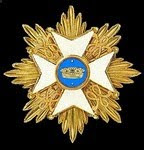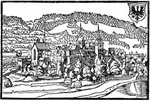First raised 1665. Commanding officers: From 1683 Oberst Charles de la Motte-Chevallerie (died 1702 as General-Major); 1702-1727 Oberst David de Gauvain, a Huguenot
This unit was from the Principality of Brunswick-Celle which was absorbed by Hanover in 1705. From 1702 this regiment was a subsidy regiment which served with the allies against the French through much of the War of the Spanish Succession.
When fighting against the French in 1674 the regiment wore green coats with red facings and the French called them les perroquets, the parrots. Colonel Churchill, later Duke of Marlborough, was at that time commanding a French regiment under Turenne and the regiment stopped his attack at the centre of the allied army. When the Celle troops joined the allies against the French in the War of the Spanish Succession he is supposed to have asked where the brave perroquets were. Uniform colours went from green to white (with various facings) in the late 1680s and into the 1690s, and by 1704 were red with black facings. For full details of all the uniform changes, see Hall's book (title below).
The flags depicted are based on one captured in 1693 and depicted in the Triomphes Louis XIV. Flags of this pattern were possibly carried up to 1702 but a different design was probably carried from 1704 under Gauvain. I shall probably eventually depict the flag carried by the unit under Gauvain, as depicted in Hall's book on the Uniforms and Flags of the Armies of Hanover, Celle and Brunswick 1670-1715. (The book is currently on special offer on the Pike and Shot webpage here: https://pikeandshotsociety.org.uk/store-2/?model_number=Uniforms-and-Flags-of-the-Armies-of-Hanover-Celle-and-Brunswick-1670-1715 It is still not cheap, even so, but is well worth the price for all the well-researched detail it provides.)
Service from 1674 (selected from the detailed list of camps and actions in Hall):
1674 Battle of Enzheim; 90 killed (KIA) and 90 wounded in action (WIA)
1675 Battle of Türkheim; siege of Trier
1676 Pomerania: Sieges of Bremen, Stade, Anklam and Demmin
1677 Pomerania: Siege of Stettin
1678 Pomerania: Siege of Stralsund
1685 Hungary: Battle of Grana; siege of Neuhäusel
1689 Flanders: Battle of Walcourt; Rhine: siege of Mainz followed by the taking of the city with 61 KIA and 100 WIA; siege of Bonn
1693 Flanders: Battle of Landen: Hungary: siege of Belgrade with 8 KIA and 32 WIA
1695 Flanders: Siege of Namur
1702 Rhine: Cannonade of Sessenberg; siege of Stephanswerth; disarming of Brunswick
1702 Flanders: Siege of Liege with 6 KIA and 12 WIA
1704 Bavaria: Battle of Schellenberg with 3 KIA, 3 WIA and 7 missing
1704 Bavaria: Battle of Blenheim with 34 KIA and 65 WIA
1706 Flanders: Siege of Menin
1708 Flanders: Battle of Oudenarde with 1 KIA and 10 WIA
1708 Flanders: Combat of Wijnendale with 4 KIA and 30 WIA
1709 Flanders: Siege of Tournai
1709 Flanders: Battle of Maplaquet with 43 KIA and 218 WIA
1710 Flanders: Siege of Douai with 48 KIA and 126 WIA
1711 Flanders: Siege of Bouchain
And these may have been the uniforms from 1692-1704, although the blue facings are debatable (after Hall):



































































